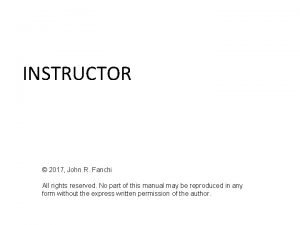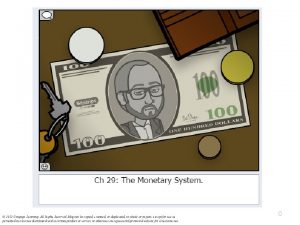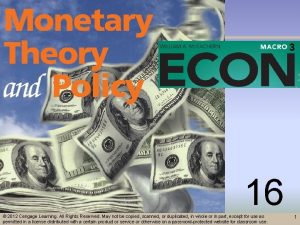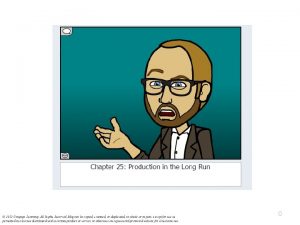13 2012 Cengage Learning All Rights Reserved May









































- Slides: 41

13 © 2012 Cengage Learning. All Rights Reserved. May not be copied, scanned, or duplicated, in whole or in part, except for use as permitted in a license distributed with a certain product or service or otherwise on a password-protected website for classroom use. 1

The Federal Budget Process • Federal budget – A plan for federal government outlays and revenues – For a specified period, usually a year • Federal outlays – Government purchases – Transfer payments (redistributed income) • Social Security and Medicare: 32% of outlays • Welfare: 16% of outlays © 2012 Cengage Learning. All Rights Reserved. May not be copied, scanned, or duplicated, in whole or in part, except for use as permitted in a license distributed with a certain product or service or otherwise on a password-protected website for classroom use. 2

Exhibit 1 Defense’s Share of Federal Outlays Declined Since 1960 and Redistribution Increased © 2012 Cengage Learning. All Rights Reserved. May not be copied, scanned, or duplicated, in whole or in part, except for use as permitted in a license distributed with a certain product or service or otherwise on a password-protected website for classroom use. 3

Presidential & Congressional Roles • The President – Budget proposal • Budget request from each agency • “The budget of US government” to Congress – Council of Economic Advisors • “Economic report of the President” • House and Senate – Budget committees: Budget resolution © 2012 Cengage Learning. All Rights Reserved. May not be copied, scanned, or duplicated, in whole or in part, except for use as permitted in a license distributed with a certain product or service or otherwise on a password-protected website for classroom use. 4

Presidential & Congressional Roles • Budget resolution – Congressional agreement about • Total outlays • Spending by major category • Expected revenues – Guides spending and revenue decisions • By the many congressional committees and subcommittees © 2012 Cengage Learning. All Rights Reserved. May not be copied, scanned, or duplicated, in whole or in part, except for use as permitted in a license distributed with a certain product or service or otherwise on a password-protected website for classroom use. 5

Presidential & Congressional Roles • Budget deficit: Outlays > Revenues – Stimulates AD in short-run – Reduces national saving – Long-run: hinder economic growth • Budget surplus: Revenues > Outlays – Dampens AD in short-run – Boosts domestic saving – Long-run: promote economic growth © 2012 Cengage Learning. All Rights Reserved. May not be copied, scanned, or duplicated, in whole or in part, except for use as permitted in a license distributed with a certain product or service or otherwise on a password-protected website for classroom use. 6

Problems • Problems with the federal budget process – Continuing resolutions • Instead of budget decisions – Lengthy budget process – Uncontrollable budget items • Entitlement programs – No separate capital budget – Overly detailed budget © 2012 Cengage Learning. All Rights Reserved. May not be copied, scanned, or duplicated, in whole or in part, except for use as permitted in a license distributed with a certain product or service or otherwise on a password-protected website for classroom use. 7

Possible Budget Reforms • Biennial budget (two-year budget) • Simplify the budget document • Federal spending – Capital budget – Operating budget © 2012 Cengage Learning. All Rights Reserved. May not be copied, scanned, or duplicated, in whole or in part, except for use as permitted in a license distributed with a certain product or service or otherwise on a password-protected website for classroom use. 8

Fiscal Impact of Federal Deficits • Rationale for deficits – Outlays that increase economy’s productivity • Budget philosophies and deficits – Annually balanced budget – Cyclically balanced budget – Functional finance © 2012 Cengage Learning. All Rights Reserved. May not be copied, scanned, or duplicated, in whole or in part, except for use as permitted in a license distributed with a certain product or service or otherwise on a password-protected website for classroom use. 9

Fiscal Impact of Federal Deficits • Annually balanced budget – Prior to the Great Depression – Aimed at matching annual revenues with outlays – Except during times of war © 2012 Cengage Learning. All Rights Reserved. May not be copied, scanned, or duplicated, in whole or in part, except for use as permitted in a license distributed with a certain product or service or otherwise on a password-protected website for classroom use. 10

Fiscal Impact of Federal Deficits • Cyclically balanced budget – Budget deficits during recessions – To be financed by budget surpluses during expansions • Functional finance – Using fiscal policy to achieve the economy’s potential GDP – Rather than balancing budgets either annually or over the business cycle © 2012 Cengage Learning. All Rights Reserved. May not be copied, scanned, or duplicated, in whole or in part, except for use as permitted in a license distributed with a certain product or service or otherwise on a password-protected website for classroom use. 11

History of Federal Deficits • 1789 -1930 – Deficit: 33% of years (war) • Since the Great Depression – Deficit: 85% of years • 1980 s relatively large deficits – Large tax cuts – High defense spending © 2012 Cengage Learning. All Rights Reserved. May not be copied, scanned, or duplicated, in whole or in part, except for use as permitted in a license distributed with a certain product or service or otherwise on a password-protected website for classroom use. 12

History of Federal Deficits • 1990 s: improved economy – Decreasing deficits – By 1998: surplus • 2001 recession – Tax cuts, Higher federal spending – Deficits • Weak recovery, war against terrorism – 2003, deficit 3. 5 % of GDP © 2012 Cengage Learning. All Rights Reserved. May not be copied, scanned, or duplicated, in whole or in part, except for use as permitted in a license distributed with a certain product or service or otherwise on a password-protected website for classroom use. 13

History of Federal Deficits • 2007 stronger economy, rising stock market – Deficit 1. 2% of GDP • Global financial crisis and the recession of 2007– 2009 – Reduced revenues and expanded outlays • 2010 deficit: $1. 3 trillion (8. 9% of GDP) • 2011 deficit: $1. 6 trillion (10. 9% of GDP) © 2012 Cengage Learning. All Rights Reserved. May not be copied, scanned, or duplicated, in whole or in part, except for use as permitted in a license distributed with a certain product or service or otherwise on a password-protected website for classroom use. 14

Exhibit 2 The Federal Deficit Relative to GDP Ballooned Recently © 2012 Cengage Learning. All Rights Reserved. May not be copied, scanned, or duplicated, in whole or in part, except for use as permitted in a license distributed with a certain product or service or otherwise on a password-protected website for classroom use. 15

Why Deficits Persist • Decreasing tax revenues • Increasing government outlays • Federal officials – Not required to balance the budget • Elected officials: maximize political support – Big spending programs – Small taxes – Pork-barrel spending © 2012 Cengage Learning. All Rights Reserved. May not be copied, scanned, or duplicated, in whole or in part, except for use as permitted in a license distributed with a certain product or service or otherwise on a password-protected website for classroom use. 16

Crowding Out and Crowding In • Increase federal deficits with government stimulus – National saving - reduced – Interest rates - higher – Crowd out private investment • Because of higher interest rates – Crowd in private investment • Because of optimistic business expectations © 2012 Cengage Learning. All Rights Reserved. May not be copied, scanned, or duplicated, in whole or in part, except for use as permitted in a license distributed with a certain product or service or otherwise on a password-protected website for classroom use. 17

The Twin Deficits • Finance huge fiscal deficits – U. S. Treasury – sells IOUs – High interest rates – Greater demand for $ • Dollar appreciation – U. S. trade deficit increase – Foreigners buy U. S. assets • Increase in foreign investment – Offset a decline in U. S. savings © 2012 Cengage Learning. All Rights Reserved. May not be copied, scanned, or duplicated, in whole or in part, except for use as permitted in a license distributed with a certain product or service or otherwise on a password-protected website for classroom use. 18

The Short-Lived Budget Surplus • Tax increases – 1990, spending cuts, Bush – 1993, increase tax rate, Clinton – Vigorous economic recovery – Increased federal revenue © 2012 Cengage Learning. All Rights Reserved. May not be copied, scanned, or duplicated, in whole or in part, except for use as permitted in a license distributed with a certain product or service or otherwise on a password-protected website for classroom use. 19

The Short-Lived Budget Surplus • Slower growth in federal outlays – 1990 -2000 Reduced US military abroad • 30% drop in defense spending – Little domestic spending growth – Interest rates decreased – Decrease in federal outlays © 2012 Cengage Learning. All Rights Reserved. May not be copied, scanned, or duplicated, in whole or in part, except for use as permitted in a license distributed with a certain product or service or otherwise on a password-protected website for classroom use. 20

The Short-Lived Budget Surplus • A reversal of fortune in 2001 – Recession + Terrorist attacks – Great federal spending – Cut taxes – 2002 Federal deficit © 2012 Cengage Learning. All Rights Reserved. May not be copied, scanned, or duplicated, in whole or in part, except for use as permitted in a license distributed with a certain product or service or otherwise on a password-protected website for classroom use. 21

The Short-Lived Budget Surplus • Financial crisis of 2008 and recession of 2007– 2009 – Increased budget deficits – Lower federal revenues • Falling employment, income, and profits • Discretionary tax cuts – Increased federal spending • Automatic stabilizers • Discretionary spending © 2012 Cengage Learning. All Rights Reserved. May not be copied, scanned, or duplicated, in whole or in part, except for use as permitted in a license distributed with a certain product or service or otherwise on a password-protected website for classroom use. 22

Exhibit 3 The Sharp Recession of 2007— 2009 Cut Federal Revenues/Increased Outlays, Result: Huge Deficits © 2012 Cengage Learning. All Rights Reserved. May not be copied, scanned, or duplicated, in whole or in part, except for use as permitted in a license distributed with a certain product or service or otherwise on a password-protected website for classroom use. 23

The Short-Lived Budget Surplus • Federal deficit – $161 billion in 2007 – $459 billion in 2008 – $1. 4 trillion in 2009 – $1. 3 trillion in 2010 – Projected $1. 6 trillion in 2011 – Projected $1. 1 trillion in 2012 © 2012 Cengage Learning. All Rights Reserved. May not be copied, scanned, or duplicated, in whole or in part, except for use as permitted in a license distributed with a certain product or service or otherwise on a password-protected website for classroom use. 24

Relative Size of the Public Sector • Federal, state, and local governments – Government outlays relative to GDP – U. S. • 38% in 1993 • 40% in 2012 – Ten-country average: 45% © 2012 Cengage Learning. All Rights Reserved. May not be copied, scanned, or duplicated, in whole or in part, except for use as permitted in a license distributed with a certain product or service or otherwise on a password-protected website for classroom use. 25

Exhibit 4 Government Outlays as a Percentage of GDP in 1993 and 2012 Government outlays relative to GDP increased in 3 of the 10 industrial economies and decreased in 7 between 1993 and 2012 The ten-country average remained unchanged at 45%. In the United States, the percentage increased from 38% to 40%. © 2012 Cengage Learning. All Rights Reserved. May not be copied, scanned, or duplicated, in whole or in part, except for use as permitted in a license distributed with a certain product or service or otherwise on a password-protected website for classroom use. 26

The National Debt • National debt – Net accumulation of federal budget deficits – Gross debt – Debt held by the public © 2012 Cengage Learning. All Rights Reserved. May not be copied, scanned, or duplicated, in whole or in part, except for use as permitted in a license distributed with a certain product or service or otherwise on a password-protected website for classroom use. 27

The National Debt • Gross debt, $16. 7 trillion in 2012 – US Treasury notes purchased by various federal agencies • Federal government owes this debt to itself • Debt held by the public, $11. 5 trillion in 2012 – US Treasury securities held by • Households; Firms • Banks (include the Fed) • Foreign entities © 2012 Cengage Learning. All Rights Reserved. May not be copied, scanned, or duplicated, in whole or in part, except for use as permitted in a license distributed with a certain product or service or otherwise on a password-protected website for classroom use. 28

Exhibit 5 Federal Debt Held by the Public as Percent of GDP Spiked Recently The huge cost of World War II rocketed federal debt from 44% of GDP in 1940 to over 109% by 1946. During the next few decades, GDP grew faster than federal debt so by 1980, federal debt had dropped to only 26% of GDP. But high deficits in recent years increased federal debt to a projected 75% relative to GDP by 2012. © 2012 Cengage Learning. All Rights Reserved. May not be copied, scanned, or duplicated, in whole or in part, except for use as permitted in a license distributed with a certain product or service or otherwise on a password-protected website for classroom use. 29

The National Debt • International perspective on public debt – Different economies • Different fiscal structures – Average 62% relative to GDP – U. S. : 81% – Australia: 8% – Japan: 134% © 2012 Cengage Learning. All Rights Reserved. May not be copied, scanned, or duplicated, in whole or in part, except for use as permitted in a license distributed with a certain product or service or otherwise on a password-protected website for classroom use. 30

Exhibit 6 Relative to GDP, U. S. Net Public Debt Above Average for Major Economies in 2012 © 2012 Cengage Learning. All Rights Reserved. May not be copied, scanned, or duplicated, in whole or in part, except for use as permitted in a license distributed with a certain product or service or otherwise on a password-protected website for classroom use. 31

Interest on the National Debt • Buyers of federal securities – Individuals, $25 U. S. savings bonds – Institutions, $1 million Treasury securities • Nearly half the debt is refinanced every year – $11. 9 trillion debt held by the public – A 1 percentage point increase in the nominal interest rate • Increases interest costs by $119 billion a year © 2012 Cengage Learning. All Rights Reserved. May not be copied, scanned, or duplicated, in whole or in part, except for use as permitted in a license distributed with a certain product or service or otherwise on a password-protected website for classroom use. 32

Exhibit 7 Interest Payments on Federal Debt Held by the Public as % of Federal Outlays Peaked in 1996 After remaining relatively constant during the 1960 s and 1970 s, interest payments as a share of federal outlays climbed during the 1980 s and early 1990 s because of growing deficits and higher interest rates. After peaking in 1996 at 15. 4 percent of outlays, interest payments declined first because of budget surpluses and later because of declining interest rates. © 2012 Cengage Learning. All Rights Reserved. May not be copied, scanned, or duplicated, in whole or in part, except for use as permitted in a license distributed with a certain product or service or otherwise on a password-protected website for classroom use. 33

Are Persistent Deficits Sustainable? • How long can the country run a deficit? – As long as lenders are willing to finance that deficit at reasonable interest rates • Depends on the confidence that lenders have about getting repaid • U. S. government securities – Considered the safest in the world – Helped us finance our chronic deficits and rising debt © 2012 Cengage Learning. All Rights Reserved. May not be copied, scanned, or duplicated, in whole or in part, except for use as permitted in a license distributed with a certain product or service or otherwise on a password-protected website for classroom use. 34

Are Persistent Deficits Sustainable? • Global financial panic – Encouraged investors around the globe to buy U. S. securities – Drove down the interest rate the U. S. government had to pay • Reducing the cost of servicing our debt © 2012 Cengage Learning. All Rights Reserved. May not be copied, scanned, or duplicated, in whole or in part, except for use as permitted in a license distributed with a certain product or service or otherwise on a password-protected website for classroom use. 35

Are Persistent Deficits Sustainable? • Countries can continue to run deficits – As long as the cost of servicing the resulting debt remains manageable – As long as the economy is growing at least as fast as the debt service payments • Those deficits should be manageable • Trillion dollar deficits are not sustainable © 2012 Cengage Learning. All Rights Reserved. May not be copied, scanned, or duplicated, in whole or in part, except for use as permitted in a license distributed with a certain product or service or otherwise on a password-protected website for classroom use. 36

Who Bears the Burden of the Debt? • Deficit spending – Billing future taxpayers for current spending • We owe it to ourselves – Future generations • Service the debt • Receive the payments • Foreign ownership of debt – Increase burden of debt on future generations of Americans © 2012 Cengage Learning. All Rights Reserved. May not be copied, scanned, or duplicated, in whole or in part, except for use as permitted in a license distributed with a certain product or service or otherwise on a password-protected website for classroom use. 37

Exhibit 8 Largest Foreign Holders of U. S. Treasury Securities as of April 2011 © 2012 Cengage Learning. All Rights Reserved. May not be copied, scanned, or duplicated, in whole or in part, except for use as permitted in a license distributed with a certain product or service or otherwise on a password-protected website for classroom use. 38

Crowding Out &Capital Formation • Government borrowing – Can drive up interest rates – Crowding out some private investment • Long-run effect of deficit spending – Depends on how the government spends the borrowed funds © 2012 Cengage Learning. All Rights Reserved. May not be copied, scanned, or duplicated, in whole or in part, except for use as permitted in a license distributed with a certain product or service or otherwise on a password-protected website for classroom use. 39

Crowding Out &Capital Formation • If borrowed dollars are invested in public capital – Better highways and a more educated workforce – Enhance productivity in the long run © 2012 Cengage Learning. All Rights Reserved. May not be copied, scanned, or duplicated, in whole or in part, except for use as permitted in a license distributed with a certain product or service or otherwise on a password-protected website for classroom use. 40

Crowding Out &Capital Formation • If borrowed dollars go toward current expenditures – More farm subsidies or higher retirement – Less capital formation – Less capital in the future – Hurting labor productivity and our future standard of living © 2012 Cengage Learning. All Rights Reserved. May not be copied, scanned, or duplicated, in whole or in part, except for use as permitted in a license distributed with a certain product or service or otherwise on a password-protected website for classroom use. 41
 2012 cengage learning
2012 cengage learning Specification by example
Specification by example Copyright 2015 all rights reserved
Copyright 2015 all rights reserved All rights reserved sentence
All rights reserved sentence Freesound content licence
Freesound content licence Confidential all rights reserved
Confidential all rights reserved All rights reserved example
All rights reserved example Copyright 2015 all rights reserved
Copyright 2015 all rights reserved 2012 pearson education inc
2012 pearson education inc Microsoft corporation. all rights reserved.
Microsoft corporation. all rights reserved. Microsoft corporation. all rights reserved.
Microsoft corporation. all rights reserved. Microsoft corporation. all rights reserved.
Microsoft corporation. all rights reserved. Pearson education inc. all rights reserved
Pearson education inc. all rights reserved Dell all rights reserved copyright 2009
Dell all rights reserved copyright 2009 Warning all rights reserved
Warning all rights reserved C all rights reserved
C all rights reserved Quadratic equation cengage
Quadratic equation cengage Warning all rights reserved
Warning all rights reserved Confidential all rights reserved
Confidential all rights reserved Microsoft corporation. all rights reserved
Microsoft corporation. all rights reserved 2010 pearson education inc
2010 pearson education inc Copyright © 2018 all rights reserved
Copyright © 2018 all rights reserved Gssllc
Gssllc Copyright 2010 pearson education inc
Copyright 2010 pearson education inc 2010 pearson education inc
2010 pearson education inc Confidential all rights reserved
Confidential all rights reserved Airbus deutschland gmbh
Airbus deutschland gmbh R rights reserved
R rights reserved Rights reserved
Rights reserved Chapter 6:2 interpreting word parts
Chapter 6:2 interpreting word parts Chapter 5 learning exercises medical terminology
Chapter 5 learning exercises medical terminology Cengage learning heart diagram
Cengage learning heart diagram South-western cengage learning
South-western cengage learning 2009 delmar cengage learning
2009 delmar cengage learning 2009 delmar cengage learning
2009 delmar cengage learning Cengage learning heart diagram
Cengage learning heart diagram Chapter 1 matching medical terminology
Chapter 1 matching medical terminology Cengage learning australia
Cengage learning australia Measuring and recording apical pulse
Measuring and recording apical pulse Cengage learning
Cengage learning Cengage learning
Cengage learning Wadsworth cengage learning
Wadsworth cengage learning

































































